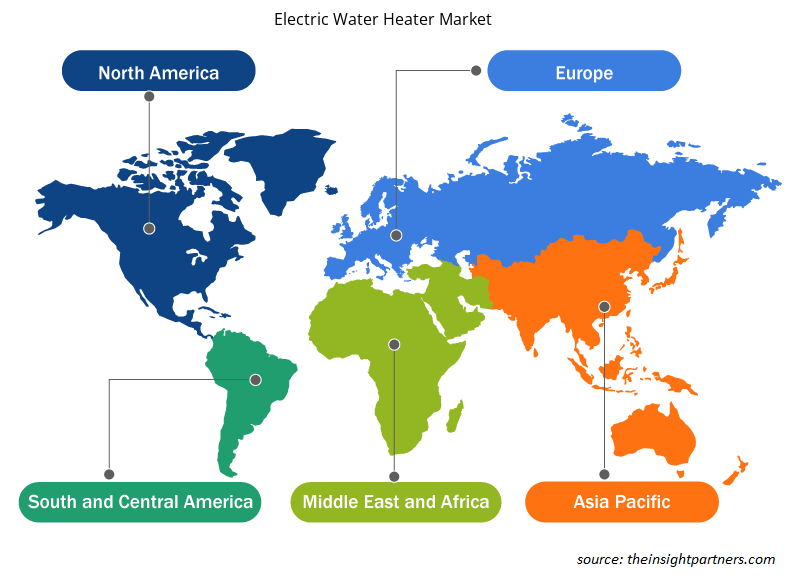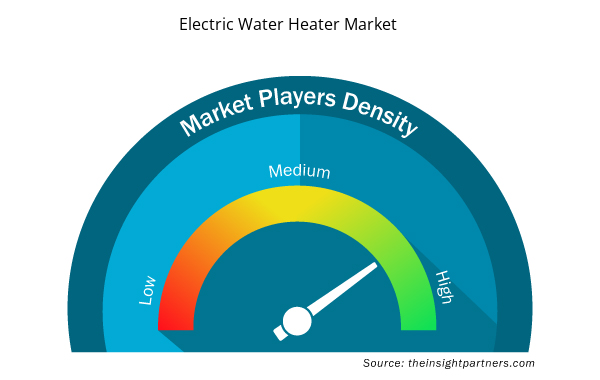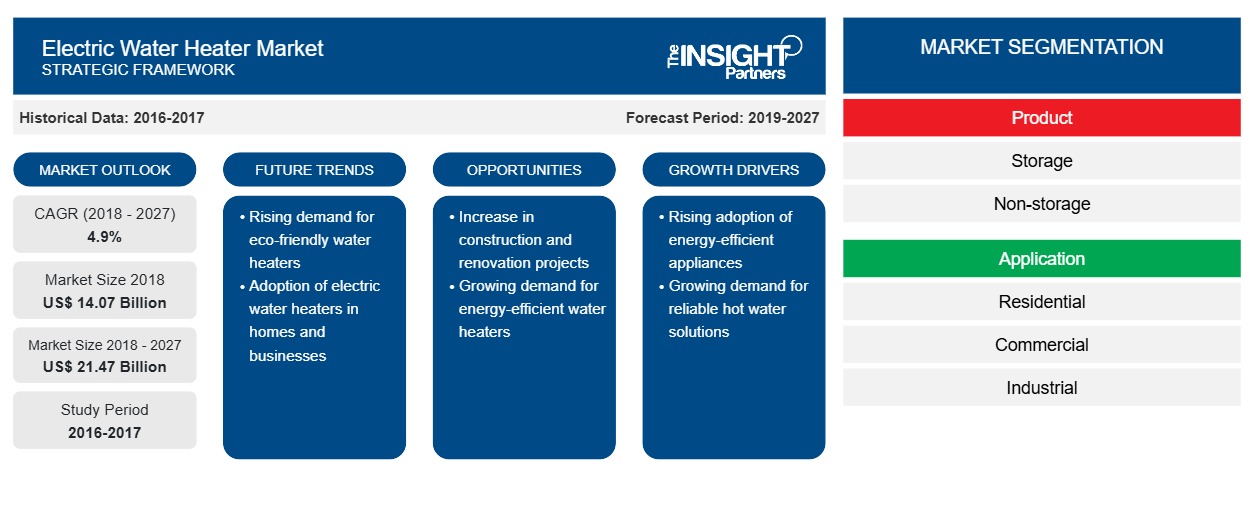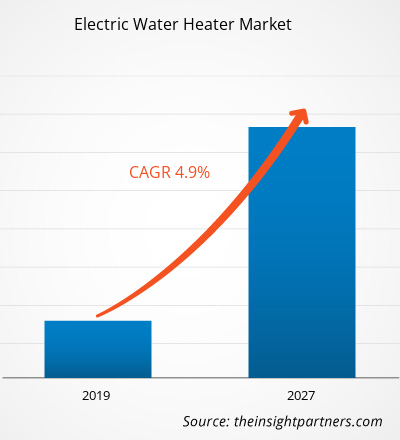Der globale Markt für elektrische Warmwasserbereiter soll von 14,07 Milliarden US-Dollar im Jahr 2018 auf 21,47 Milliarden US-Dollar im Jahr 2027 wachsen. Dies entspricht einer durchschnittlichen jährlichen Wachstumsrate von 4,9 % im Zeitraum von 2019 bis 2027.
Der asiatisch-pazifische Raum war der führende geografische Markt und wird voraussichtlich im gesamten Prognosezeitraum den höchsten Umsatzbeitrag leisten. In der Region Asien-Pazifik treibt die rasche Entwicklung der Infrastruktur verschiedener Wohn-, Gewerbe- und Industrieeinheiten den Markt für elektrische Warmwasserbereiter in der Region voran , und dieser Trend wird sich in den nächsten zehn Jahren fortsetzen.
Markteinblicke
Der Faktor der städtischen Einwanderung ist ein wichtiger Einflussfaktor für den Markt für elektrische Warmwasserbereiter
In verschiedenen Ländern weltweit ist ein enormer Trend zur Stadtmigration zu verzeichnen. Die Stadtmigration ist im 21. Jahrhundert ein wachsender Trend. Zu den wichtigsten Parametern, die den Trend zur Stadtmigration vorantreiben, gehören Beschäftigungsmöglichkeiten, Bildungsmöglichkeiten und medizinische Versorgung. Auch das steigende Einkommensniveau der Mittelschicht und ein besserer Lebensstandard sind wichtige Faktoren, die zur Stadtmigration beitragen. Der steigende Trend zur Stadtmigration hat zur Entwicklung von Wohninfrastrukturen geführt, was ein wichtiger Faktor ist, der das Wachstum des Marktes für elektrische Warmwasserbereiter im gegenwärtigen Szenario katalysiert.
Die Stadtbevölkerung profitiert mehr als die ländliche Bevölkerung und strebt nach einem höheren Lebensstandard. In Bezug auf den oben genannten Faktor bemühen sich die verschiedenen Technologieentwickler, Rohstoffhersteller, Energie- und Stromerzeugungsunternehmen, Infrastrukturentwickler und Regierungen ständig darum, die Anforderungen der Stadtbevölkerung zu erfüllen. Stadtmigration und höhere Lebensstandards, gepaart mit wachsenden Technologien und Regierungspolitiken, treiben das Wachstum der Wohninfrastruktur in verschiedenen Entwicklungsländern sowie Industrienationen voran. Die steigende Zahl der Wohninfrastruktur ermöglicht es den Marktteilnehmern für elektrische Warmwasserbereiter, eine steigende Nachfrage nach ihren jeweiligen Produkten zu verzeichnen.
Passen Sie diesen Bericht Ihren Anforderungen an
Sie erhalten kostenlos individuelle Anpassungen an jedem Bericht, einschließlich Teilen dieses Berichts oder einer Analyse auf Länderebene, eines Excel-Datenpakets sowie tolle Angebote und Rabatte für Start-ups und Universitäten.
- Holen Sie sich die wichtigsten Markttrends aus diesem Bericht.Dieses KOSTENLOSE Beispiel umfasst eine Datenanalyse von Markttrends bis hin zu Schätzungen und Prognosen.
Die weltweit wachsende Wohninfrastruktur ermöglicht es den Marktteilnehmern auf dem Markt für elektrische Warmwasserbereiter, ihre jeweilige Produktpalette zu erweitern, um eine breite Palette von Kunden anzusprechen. Das Bewusstsein für die Vorteile und Anwendungsbereiche elektrischer Warmwasserbereiter erreicht bei der städtischen Bevölkerung seinen Höhepunkt, und in diesem Zusammenhang nimmt die Nutzung dieser Geräte kontinuierlich zu, was wiederum die Umsatzgröße des Marktes für elektrische Warmwasserbereiter bestimmt. Mit der zunehmenden Migration von ländlichen in städtische Gebiete in verschiedenen Ländern wird die Nachfrage nach elektrischen Warmwasserbereitern im Wohnsektor in den kommenden Jahren stark ansteigen. Daher ist der Faktor der städtischen Einwanderung ein wichtiger Einflussfaktor für den Markt für elektrische Warmwasserbereiter während des gesamten Prognosezeitraums.
Produktinformationen
Der globale Markt für elektrische Warmwasserbereiter wurde vom Speichersegment angeführt. Das Nicht-Speichersegment hatte 2018 den zweitgrößten Markt und dürfte seine Anteile im Prognosezeitraum von 2019 bis 2027 ausbauen.
Anwendungseinblicke
Der weltweite Markt für elektrische Warmwasserbereiter wurde nach Anwendung vom Wohnsegment angeführt. Das kommerzielle Segment hielt 2018 den zweitgrößten Markt und dürfte seine Anteile im Prognosezeitraum von 2019 bis 2027 ausbauen.
Die Marktteilnehmer auf dem Markt für elektrische Warmwasserbereiter konzentrieren sich hauptsächlich auf Produktverbesserungen durch den Einsatz fortschrittlicher Technologien. Einige der jüngsten Entwicklungen sind unten aufgeführt:
2019: PHCC hat den Partnerschaftsstatus von Bradford White Corp. auf die Kategorie „Strategischer Partner“ erweitert. Die Anerkennung erweitert die Partnerschaft von ausschließlich Bradford White-Warmwasserbereitern auf die gesamte Bradford White Corp.
2019: Bradford White kündigte die Einführung seiner neuen webbasierten Auftragnehmerressource „For The Pro“ an, die auf professionelle Installateure von Bradford White-Warmwasserbereitern, Raumheizungen, Kombinationsheizungen und Speicherlösungen für private, gewerbliche und industrielle Anwendungen zugeschnitten ist.
2018: AO Smith eröffnete das neue Lloyd R. Smith Corporate Technology Center, das als globales Innovationszentrum für AO Smith-Produkte auf der ganzen Welt dienen soll.
Regionale Einblicke in den Markt für elektrische Warmwasserbereiter
Die regionalen Trends und Faktoren, die den Markt für elektrische Warmwasserbereiter im Prognosezeitraum beeinflussen, wurden von den Analysten von Insight Partners ausführlich erläutert. In diesem Abschnitt werden auch die Marktsegmente und die Geografie für elektrische Warmwasserbereiter in Nordamerika, Europa, im asiatisch-pazifischen Raum, im Nahen Osten und Afrika sowie in Süd- und Mittelamerika erörtert.

- Holen Sie sich die regionalen Daten für den Markt für elektrische Warmwasserbereiter
Umfang des Marktberichts über elektrische Warmwasserbereiter
| Berichtsattribut | Details |
|---|---|
| Marktgröße im Jahr 2018 | 14,07 Milliarden US-Dollar |
| Marktgröße bis 2027 | 21,47 Milliarden US-Dollar |
| Globale CAGR (2018 - 2027) | 4,9 % |
| Historische Daten | 2016-2017 |
| Prognosezeitraum | 2019–2027 |
| Abgedeckte Segmente | Nach Produkt
|
| Abgedeckte Regionen und Länder | Nordamerika
|
| Marktführer und wichtige Unternehmensprofile |
|
Marktteilnehmerdichte für elektrische Warmwasserbereiter: Auswirkungen auf die Geschäftsdynamik verstehen
Der Markt für elektrische Warmwasserbereiter wächst rasant, angetrieben durch die steigende Nachfrage der Endverbraucher aufgrund von Faktoren wie sich entwickelnden Verbraucherpräferenzen, technologischen Fortschritten und einem größeren Bewusstsein für die Vorteile des Produkts. Mit steigender Nachfrage erweitern Unternehmen ihr Angebot, entwickeln Innovationen, um die Bedürfnisse der Verbraucher zu erfüllen, und nutzen neue Trends, was das Marktwachstum weiter ankurbelt.
Die Marktteilnehmerdichte bezieht sich auf die Verteilung der Firmen oder Unternehmen, die in einem bestimmten Markt oder einer bestimmten Branche tätig sind. Sie gibt an, wie viele Wettbewerber (Marktteilnehmer) in einem bestimmten Marktraum im Verhältnis zu seiner Größe oder seinem gesamten Marktwert präsent sind.
Die wichtigsten auf dem Markt für elektrische Warmwasserbereiter tätigen Unternehmen sind:
- AO Smith Corporation
- Ariston Thermo SpA
- Bajaj Electricals Ltd.
- Bradford White Corp.
- Whirlpool Corporation
Haftungsausschluss : Die oben aufgeführten Unternehmen sind nicht in einer bestimmten Reihenfolge aufgeführt.

- Überblick über die wichtigsten Akteure auf dem Markt für elektrische Warmwasserbereiter
GLOBALER MARKT FÜR ELEKTRISCHE WARMWASSERHEIZUNGEN – MARKTSEGMENTIERUNG
Globaler Markt für elektrische Warmwasserbereiter nach Produkten
- Lagerung
- < 30 Liter
- 30 - 100 Liter
- 100 - 250 Liter
- 250 - 400 Liter
- > 400 Liter
- Nichtspeicherung
Globaler Markt für elektrische Warmwasserbereiter nach Anwendung
- Wohnen
- Kommerziell
- Industrie
Globaler Markt für elektrische Warmwasserbereiter nach Regionen
- Nordamerika
- Europa
- Asien-Pazifik
- Naher Osten und Afrika
- Südamerika
Erwähnte Unternehmen
- AO Smith Corporation
- Ariston Thermo Group SpA
- Bajaj Electricals Ltd.
- Bosch-Gruppe
- Bradford White Corporation (BWC)
- Haier Smart Home Co., Ltd.
- Midea Group Co., Ltd.
- Siemens AG
- Viessmann Werke GmbH & Co. KG
- Whirlpool Corporation
- Historische Analyse (2 Jahre), Basisjahr, Prognose (7 Jahre) mit CAGR
- PEST- und SWOT-Analyse
- Marktgröße Wert/Volumen – Global, Regional, Land
- Branche und Wettbewerbsumfeld
- Excel-Datensatz



Report Coverage
Revenue forecast, Company Analysis, Industry landscape, Growth factors, and Trends

Segment Covered
This text is related
to segments covered.

Regional Scope
North America, Europe, Asia Pacific, Middle East & Africa, South & Central America

Country Scope
This text is related
to country scope.
Häufig gestellte Fragen
The demand for electric water heaters is expected to increase in the developing areas as the number of houses, hotels, commerce zones, shopping malls, hospitals, and industrial buildings in the developing countries is increasing, which is demanding electric water heaters. This is due to the fact that the count of each of the commercial spaces mentioned overhead is continuously growing, which is leading to the higher procurement rate of electric water heaters. Additionally, electricity in the developing countries are comparatively cheaper than the developed countries, the cost associated with gas filling in gas water heaters is omitted, and faster heating time on electric water heaters have attracted a significant percentage of urban population residing in the countries mentioned above. This parameter is foreseen to furnish the electric water heater market in the coming years.
In the region, swift development of infrastructure of various residential, commercial, and industrial units is driving the APAC electric water heater market, and this would continue to drive in the coming ten years. The building construction investment by respective state government authorities would positively optimize the business outlook; the rising demand for electric water heaters, both storage as well as non-storage, would also augment the industry landscape.
Increasing construction activities and increase of the building infrastructure is driving the electric storage water heating demand across commercial establishments. Stringent government orders aiming to decrease the carbon footprint along with rising urbanization & commercialization would accelerate the demand for storage water heaters. Electric storage water heaters are used in various industrial applications for efficient heating. When it comes to efficiency and economy, electric storage water heaters are the best option in their category.
Trends and growth analysis reports related to Electronics and Semiconductor : READ MORE..
The List of Companies
- AO Smith Corporation
- Ariston Thermo S.p.A
- Bajaj Electricals Ltd.
- Bradford White Corp.
- Whirlpool Corporation
- Haier Inc.
- Midea Group
- Bosch Thermotechnology
- Siemens AG
- Viesmann Group
The Insight Partners performs research in 4 major stages: Data Collection & Secondary Research, Primary Research, Data Analysis and Data Triangulation & Final Review.
- Data Collection and Secondary Research:
As a market research and consulting firm operating from a decade, we have published and advised several client across the globe. First step for any study will start with an assessment of currently available data and insights from existing reports. Further, historical and current market information is collected from Investor Presentations, Annual Reports, SEC Filings, etc., and other information related to company’s performance and market positioning are gathered from Paid Databases (Factiva, Hoovers, and Reuters) and various other publications available in public domain.
Several associations trade associates, technical forums, institutes, societies and organization are accessed to gain technical as well as market related insights through their publications such as research papers, blogs and press releases related to the studies are referred to get cues about the market. Further, white papers, journals, magazines, and other news articles published in last 3 years are scrutinized and analyzed to understand the current market trends.
- Primary Research:
The primarily interview analysis comprise of data obtained from industry participants interview and answers to survey questions gathered by in-house primary team.
For primary research, interviews are conducted with industry experts/CEOs/Marketing Managers/VPs/Subject Matter Experts from both demand and supply side to get a 360-degree view of the market. The primary team conducts several interviews based on the complexity of the markets to understand the various market trends and dynamics which makes research more credible and precise.
A typical research interview fulfils the following functions:
- Provides first-hand information on the market size, market trends, growth trends, competitive landscape, and outlook
- Validates and strengthens in-house secondary research findings
- Develops the analysis team’s expertise and market understanding
Primary research involves email interactions and telephone interviews for each market, category, segment, and sub-segment across geographies. The participants who typically take part in such a process include, but are not limited to:
- Industry participants: VPs, business development managers, market intelligence managers and national sales managers
- Outside experts: Valuation experts, research analysts and key opinion leaders specializing in the electronics and semiconductor industry.
Below is the breakup of our primary respondents by company, designation, and region:

Once we receive the confirmation from primary research sources or primary respondents, we finalize the base year market estimation and forecast the data as per the macroeconomic and microeconomic factors assessed during data collection.
- Data Analysis:
Once data is validated through both secondary as well as primary respondents, we finalize the market estimations by hypothesis formulation and factor analysis at regional and country level.
- Macro-Economic Factor Analysis:
We analyse macroeconomic indicators such the gross domestic product (GDP), increase in the demand for goods and services across industries, technological advancement, regional economic growth, governmental policies, the influence of COVID-19, PEST analysis, and other aspects. This analysis aids in setting benchmarks for various nations/regions and approximating market splits. Additionally, the general trend of the aforementioned components aid in determining the market's development possibilities.
- Country Level Data:
Various factors that are especially aligned to the country are taken into account to determine the market size for a certain area and country, including the presence of vendors, such as headquarters and offices, the country's GDP, demand patterns, and industry growth. To comprehend the market dynamics for the nation, a number of growth variables, inhibitors, application areas, and current market trends are researched. The aforementioned elements aid in determining the country's overall market's growth potential.
- Company Profile:
The “Table of Contents” is formulated by listing and analyzing more than 25 - 30 companies operating in the market ecosystem across geographies. However, we profile only 10 companies as a standard practice in our syndicate reports. These 10 companies comprise leading, emerging, and regional players. Nonetheless, our analysis is not restricted to the 10 listed companies, we also analyze other companies present in the market to develop a holistic view and understand the prevailing trends. The “Company Profiles” section in the report covers key facts, business description, products & services, financial information, SWOT analysis, and key developments. The financial information presented is extracted from the annual reports and official documents of the publicly listed companies. Upon collecting the information for the sections of respective companies, we verify them via various primary sources and then compile the data in respective company profiles. The company level information helps us in deriving the base number as well as in forecasting the market size.
- Developing Base Number:
Aggregation of sales statistics (2020-2022) and macro-economic factor, and other secondary and primary research insights are utilized to arrive at base number and related market shares for 2022. The data gaps are identified in this step and relevant market data is analyzed, collected from paid primary interviews or databases. On finalizing the base year market size, forecasts are developed on the basis of macro-economic, industry and market growth factors and company level analysis.
- Data Triangulation and Final Review:
The market findings and base year market size calculations are validated from supply as well as demand side. Demand side validations are based on macro-economic factor analysis and benchmarks for respective regions and countries. In case of supply side validations, revenues of major companies are estimated (in case not available) based on industry benchmark, approximate number of employees, product portfolio, and primary interviews revenues are gathered. Further revenue from target product/service segment is assessed to avoid overshooting of market statistics. In case of heavy deviations between supply and demand side values, all thes steps are repeated to achieve synchronization.
We follow an iterative model, wherein we share our research findings with Subject Matter Experts (SME’s) and Key Opinion Leaders (KOLs) until consensus view of the market is not formulated – this model negates any drastic deviation in the opinions of experts. Only validated and universally acceptable research findings are quoted in our reports.
We have important check points that we use to validate our research findings – which we call – data triangulation, where we validate the information, we generate from secondary sources with primary interviews and then we re-validate with our internal data bases and Subject matter experts. This comprehensive model enables us to deliver high quality, reliable data in shortest possible time.


 Holen Sie sich ein kostenloses Muster für diesen Bericht
Holen Sie sich ein kostenloses Muster für diesen Bericht